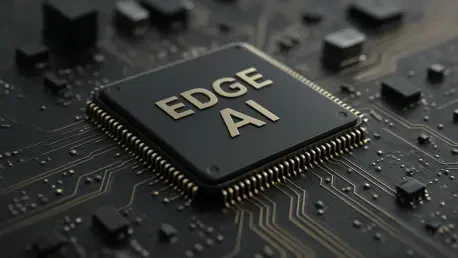In an era where technology evolves at a breakneck pace, edge AI chips stand out as a game-changing innovation set to redefine the landscape by 2034. These specialized semiconductor components are engineered to process artificial intelligence algorithms directly on devices near the data source, bypassing the need for distant cloud servers. This shift enables real-time data handling with minimal latency, slashes bandwidth requirements, and bolsters privacy by keeping sensitive information local. From powering smartphones with instant voice recognition to enabling self-driving cars to make split-second decisions, edge AI chips are becoming the cornerstone of modern tech across diverse industries. Their ability to deliver speed, efficiency, and security addresses some of the most pressing challenges in computing today.
Picture a world where devices anticipate needs and react instantaneously without a cloud connection. Edge AI chips make this vision tangible by performing complex computations on-site, whether it’s a factory robot adapting to sudden changes or a wearable device monitoring health metrics in real time. The global market for these chips, valued at USD 7.05 billion in 2024, is projected to soar to USD 36.12 billion by 2034, reflecting a robust compound annual growth rate of 17.75%. This explosive trajectory underscores their transformative potential. As industries and consumers increasingly adopt AI-driven solutions, the question arises: what forces are propelling this growth, and how will edge AI chips shape technology over the next decade?
The Catalysts Fueling Edge AI Chip Growth
The surge in edge AI chip adoption is primarily driven by the urgent demand for real-time decision-making in critical applications. In sectors like autonomous vehicles and industrial automation, even a millisecond of delay in data processing via cloud servers can lead to severe consequences. Edge AI chips address this by executing computations locally, ensuring immediate responses that enhance both safety and operational efficiency. This capability is poised to revolutionize industries where timing is everything, setting the stage for widespread integration into systems that prioritize precision by 2034. As technology continues to underpin safety-critical operations, the reliance on local processing will only deepen.
Beyond timing, privacy and security concerns are accelerating the shift to edge AI solutions. Transmitting sensitive data to the cloud introduces vulnerabilities to breaches and regulatory complications, particularly in fields like healthcare and finance where confidentiality is paramount. By processing data on-device, edge AI chips significantly reduce these risks, offering a safer alternative that aligns with growing consumer and business demands for data protection. Over the next decade, as regulations tighten and public awareness of privacy issues grows, this feature will likely become a key factor in driving market expansion, positioning edge AI as a trusted foundation for secure technology ecosystems.
Additionally, the advent of 5G technology acts as a powerful enabler for edge AI chips. With its ability to support rapid data transmission and connect a vast array of devices, 5G creates an optimal environment for edge computing to thrive. This synergy paves the way for groundbreaking innovations in areas such as augmented reality, remote surgical procedures, and smart city infrastructure. By 2034, the integration of 5G with edge AI is expected to redefine connectivity, making real-time analytics and seamless device interaction a standard across multiple sectors. This technological marriage will unlock new possibilities for how society leverages connected systems.
Obstacles on the Path to Edge AI Dominance
Despite their promise, edge AI chips face substantial challenges that could temper their trajectory toward 2034. One of the most significant barriers is the steep cost of development. Crafting these advanced semiconductors requires hefty investments in research, specialized hardware, and cutting-edge manufacturing processes, often running into tens of millions of dollars. Such financial demands create a high entry barrier, limiting participation to larger corporations and potentially stifling innovation from smaller players. Addressing this economic hurdle will be essential to ensure a diverse and dynamic market landscape in the coming years, as broader access to resources could spur faster advancements.
Another critical challenge lies in energy consumption and thermal management. High-performance AI tasks, when executed on edge devices, can rapidly deplete battery life, especially in portable gadgets like wearables or remote sensors used in IoT applications. Furthermore, the heat generated during intensive processing can compromise device reliability if not adequately managed. These efficiency concerns pose significant obstacles for sustained use in compact or mobile setups. By 2034, overcoming these power and cooling issues through innovative design and materials will be vital to meeting the growing demand for reliable, long-lasting edge AI solutions across various applications.
Sector-Specific Revolutions Driven by Edge AI
In the realm of consumer electronics, edge AI chips already command a significant presence, holding a 40% market share as of 2024. These chips power everyday devices like smartphones and smart home systems, enabling features such as instant voice assistance and adaptive image processing without cloud dependency. Their seamless integration enhances user experiences by making technology more intuitive and responsive. By 2034, it’s anticipated that edge AI will become an invisible yet indispensable part of daily tech, embedded so deeply into devices that AI-driven interactions feel entirely natural, reshaping how consumers engage with their surroundings.
The automotive industry, however, stands to experience the most profound transformation through edge AI. These chips facilitate real-time processing of sensor data in autonomous vehicles, enabling critical functions like collision avoidance and navigational decision-making independent of external servers. This on-device capability ensures reliability even in areas with poor connectivity, a crucial factor for safety. As self-driving technology advances toward mainstream adoption by 2034, edge AI chips will form the backbone of secure, independent vehicle systems, supported by government policies promoting smart mobility and fostering a new era of transportation innovation.
Healthcare also emerges as a key beneficiary of edge AI advancements. By processing patient data locally on medical devices, these chips enable rapid diagnostics and monitoring while safeguarding sensitive information from external vulnerabilities. This approach is particularly transformative for remote care and wearable health technologies, where immediate feedback can be life-saving. Looking toward 2034, edge AI is expected to drive personalized healthcare solutions, allowing for real-time health insights without compromising privacy, and potentially reducing the burden on centralized systems as telemedicine and home-based care continue to expand.
Global Dynamics and Regional Leadership
Regionally, Asia Pacific dominates the edge AI chips market, holding a 35% share in 2024, largely due to its robust semiconductor manufacturing base and swift adoption of AI across consumer and industrial sectors. With a projected market value of USD 12.82 billion by 2034, the region’s leadership is reinforced by government-backed initiatives for smart city projects and significant investments in IoT infrastructure. This strong foundation suggests that Asia Pacific will maintain its pivotal role in driving global market growth over the next decade, serving as a hub for both production and implementation of edge AI technologies.
In contrast, North America is identified as the fastest-growing region in this space, propelled by substantial investments in AI-driven edge computing and early adoption in critical sectors such as healthcare and defense. The region’s vibrant ecosystem of technological innovators and venture-funded startups fuels rapid development and deployment of cutting-edge applications. By 2034, North America could emerge as a leader in pioneering new uses for edge AI chips, leveraging its culture of innovation to push boundaries in how these technologies are applied across industries, potentially setting global standards for performance and integration.
Cutting-Edge Innovations Powering Future Growth
On the hardware side, Application-Specific Integrated Circuits (ASICs) lead the market with a 35% share in 2024, prized for their tailored performance in tasks like image recognition and voice processing. Their efficiency and low latency make them ideal for specific AI applications in devices ranging from smartphones to IoT systems. However, Neural Processing Units (NPUs) are forecasted to see the fastest growth, driven by rising needs for deep learning and real-time inference in fields like robotics and autonomous driving. By 2034, NPUs are expected to play a central role in enabling more complex and adaptive AI functionalities at the edge.
Software advancements are equally critical to the edge AI landscape, with frameworks and development tools evolving to simplify model optimization for edge devices. This segment’s rapid growth reflects a demand for solutions that bridge hardware capabilities with application-specific needs, empowering developers to create customized AI experiences. As the market progresses toward 2034, software will likely become a key differentiator, enabling seamless integration and scalability across diverse platforms, thus broadening the accessibility and impact of edge AI technologies in both consumer and industrial contexts.
Moreover, progress in smaller technology nodes, such as 7 nm and below, is revolutionizing edge AI chip performance. These compact nodes enhance transistor density, reduce power consumption, and boost overall efficiency, making them perfect for small devices like wearables and IoT gadgets. Leading semiconductor manufacturers are already investing heavily in 5 nm and 3 nm technologies to meet future demands. By 2034, these advancements will likely result in more powerful yet energy-efficient edge AI chips, facilitating their integration into an even wider array of applications and driving the next wave of technological innovation.
Envisioning a Decentralized Tech Horizon
Reflecting on the journey of edge AI chips, their rise has been marked by an unprecedented push toward decentralized computing, addressing the limitations of cloud-centric models with remarkable success. By 2034, the market is expected to expand from a valuation of USD 7.05 billion in 2024 to an impressive USD 36.12 billion, driven by the critical need for low-latency processing and stringent privacy demands. The synergy with 5G has unlocked new frontiers in connectivity, while challenges like high development costs and energy constraints are being met with innovative solutions over the decade.
Looking ahead, the focus must shift to democratizing access to edge AI technology. Stakeholders across the semiconductor ecosystem should prioritize collaborative efforts to lower entry barriers, perhaps through open-source platforms or shared R&D initiatives, ensuring smaller players can contribute to innovation. Additionally, investing in sustainable design practices to tackle energy challenges will be vital for scaling adoption in power-sensitive applications. As industries continue to evolve, fostering partnerships between chip manufacturers, software developers, and sector-specific leaders will be key to tailoring solutions that meet unique needs, solidifying edge AI chips as the bedrock of a smarter, more connected future.









